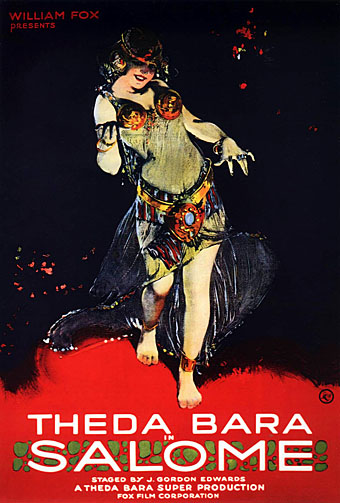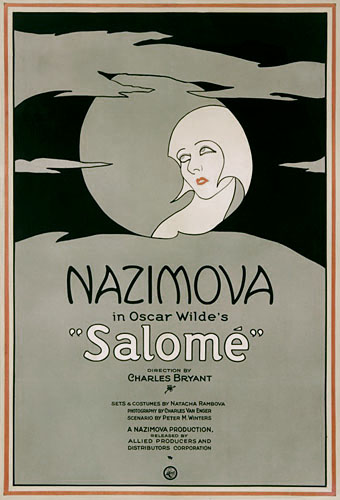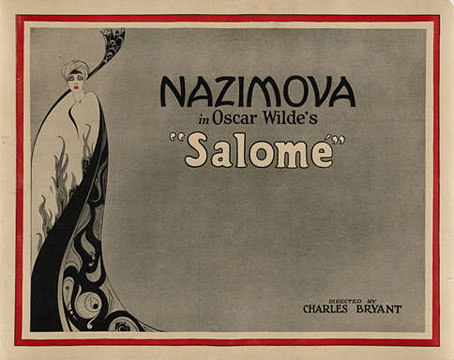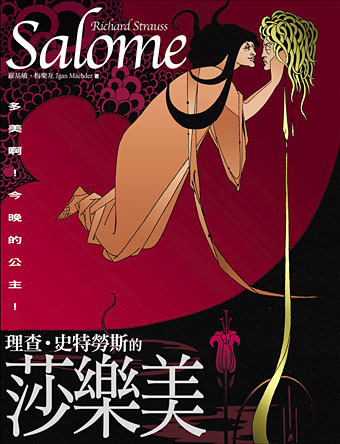Salome (1918).
You can’t keep a bad girl down… Attempting to gather all the painted representations of Salomé would be a foolish enterprise, there are far too many especially when you reach the 19th century, an age whose misogyny found an ideal expression in the emasculating temptress. Searching through 20th century adaptations yields some interesting works, however.
Theda Bara’s film pre-dates the more flamboyant Nazimova version by five years, and since I haven’t seen it I’ve no idea how it holds up today. But from the look of the stills and posters it seems far closer to the usual historical fare than the stylised version which followed.
Salomé (1923).
I’ve written about Nazimova’s silent adaptation of Wilde’s play in an earlier post so there’s no need to go into detail here. Back then I didn’t have a credit for the very Beardsley-esque posters and lobby cards which it transpires are the work of Eugene Gise and Natacha Rambova, the latter being the film’s costume and set designer.
Salomé (1923).
Salome (2002).
Richard Strauss’s 1905 opera adaptation of Wilde’s play receives far more performances than the play itself, and this poster is one of four created for a recent Canadian production.
Salome (2006).
And this isn’t a poster but it brings us back to Beardsley with an attractive cover for a Taiwanese (?) book. Impossible to tell whether this is a libretto or something else since its page is in Chinese but the colouring works rather well (although that gold streak of blood should be red) and the lettering almost takes Beardsley’s drawing back to its Japanese inspiration.
Elsewhere on { feuilleton }
• The Salomé archive






Why not golden blood? Why not, I ask.
I ‘m under the impression that Clive Barker has also adapted Wilde’s Salome for a short film. I haven’t seen it though, so I have no idea whether it was faithful to the source, or any good in general (I ‘m a fan of Barker’s, but his work can be notoriously uneven).
Evan: I did consider that in Shakespeare blood is described as gold, or so I recall from Macbeth.
Dimitris: Yes, Barker made a couple of short films with his theatre friends before Hellraiser, in the first of which he portrays Salomé. They used to be available on VHS. There’s also a photo which many people–including Wilde biographer Richard Ellman–used to believe was Oscar Wilde as Salomé but this was disproved a few years ago.
I love the colouring and Chinese type on the Beardsley image. Works really well.
Here is a video uploaded by Josye777 featuring more renditions of Salome in art, that may be of interest …
http://www.youtube.com/watch?v=vp0iHxdsyAo
Also, the contemporary graphic artist Vania Zouravliov has created some really interesting Salome images .
http://www.facebook.com/pages/Vania-Zouravliov/102182735703?ref=ts
Dimitris: If you’re a big fan of his, then I would say go ahead and see it, but otherwise its a ‘completists’ only’ affair in my opinion. One could see the burgeoning potential in his early films, a few of which are or were available through Redemption Films I believe.
Mr. Barker’s uneven nature, reminds me somewhat of a few of John’s recent posts about Richardson’s critiquing of Francis Bacon’s later work. Though I think Richardson was too harsh with Bacon, his later work was certainly interesting and unique at least, I am in agreement that his work lost much of its raw, visceral power and intriguing atmosphere once a less harmful, more harmonious tone came into his life. The same can be said of Barker, the ‘Books of Blood’ as well as his old paintings were absolutely inspired, but once love, family, and L.A. came into the picture, the hunger, angst, and frenzy that fed what was a towering inferno of inspiration, fizzled into a tamed little bonfire.
I’d have loved to see a younger Barker, amongst many others, illustrate Salome.
I agreed with Richardson for the most part. It’s a dilemma for artists who are trying to work in a personal and exploratory manner whilst at the same time being prey to the demands of the art market. Work which starts out as fresh and original gets watered down by repetition as galleries demand more of the same. It’s a theory I’ve propounded here several times, the poisoning of the art world by the market, and Bacon was as subject to that as artists are today. Artists frequently used to paint variations on a theme (Arnold Böcklin with his five versions of The Isle of the Dead for example) but things were never as bad as they are now.
It’s difficult to say whether Barker’s work is subject to the same syndrome–he genuinely seems to like producing a lot of work–although one of his galleries sends me enough newsletters about his paintings. Aside from the covers he did for the original Books of Blood I’ve always preferred his b&w work, all the brush drawings he used to do which strike me as more powerful and impressive than what I’ve seen of his oil paintings. The problem for him in the market is that collectors will demand (and pay more money for) paintings over ink drawings.
Thanks Wiley, I will check it out. I hadn’ t noticed that Richardson article on Bacon. I just read it and it’s fascinating. Very harsh, although the criticism struck me as valid. I guess any successful artist with a long career has to deal with the danger of complacence and repetition eventually; and Bacon was no exception.
With Barker, my feelings are more complex, partly because he has written of my favorite novels (Imajica) and partly because he has worked in many media, with varying degrees of success. John, you have a point about his black and white work, although I am also drawn to a lot of his color book covers (for The Books Of Blood, The Damnation Game, etc.). I would argue that he isn’t as great a director as he is an author, or a painter (Hellraiser being a notable exception). Compare the Lord Of Illusions film with the original short story, for example. I wish somebody like Guillermo Del Toro had a go with adapting his work for the screen. Still, I don’ t mean to sound dismissive, I still have a lot of time for his work and new projects.
Ken Russell directed in 1988 a curious version entitled Salome’s Last Dance
pe-jota: Yes, and it’s a film I still haven’t seen. I lost patience with Ken Russell in the 1980s, he seemed to throw away any attempt to be a serious filmmaker.
Dimitris: I was disappointed with Hellraiser: lots of great images and ideas but poorly-directed–you don’t see an exterior shot of the house where the events are taking place until about fifteen or twenty minutes in. And while I love the look of the Cenobites, I couldn’t believe it was possible to just run away from them the way one character does. It was also compromised by the studio; Coil were supposed to do the music but their work was rejected in favour of a standard horror score.
But…….there’s enough crap around at any given time (more so than ever) that carping about someone trying to be different as Barker always is, is unfair. He’s a great encouragement to be as creative as possible; it’s his imagination that counts.
Good points about Hellraiser. I like it but it’s a flawed piece of work. I think it’s the otherwordly design of the Cenobites that carries it for me. There are some unfortunate concessions to standard 80s slasher- movie cliches that compromise its vision (plus the low budget).
I ‘ve heard snippets of the Coil soundtrack and it was unsettling and evocative. I must admit I also like Christopher Young’s score though (I ‘m a sucker for lush strings and all that…).
I tried to translate the page you link to using the Google translation software. The language is Chinese, as I supposed. I found the book index and as far as I understand, the cover corresponds to a book including a collection of brief essays on Salome.